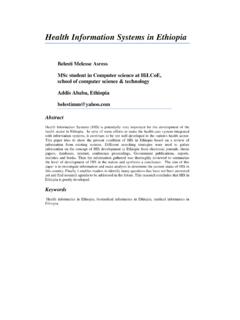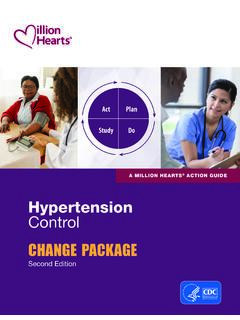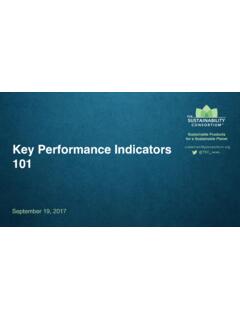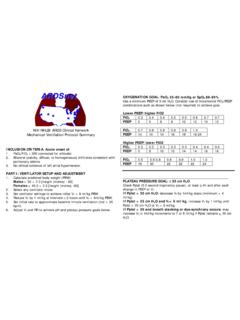Transcription of 3. Health information systems - World Health Organization
1 Health information systems43 Health information systems3. Health information systems44 Health information IntroductionSound and reliable information is the foundation of decision-making across all Health system building blocks. It is essential for Health system policy development and implementation, governance and regulation, Health research, human resources development, Health education and training, service delivery and Health information system provides the underpinnings for decision-making and has four key functions: (i) data generation, (ii) compilation, (iii) analysis and synthesis, and (iv) communication and use.
2 The Health information system collects data from Health and other relevant sectors, analyses the data and ensures their overall quality, relevance and timeliness, and converts the data into information for Health -related decision-making (1).The Health information system is sometimes equated with monitoring and evaluation but this is too reductionist a perspective. In addition to being essential for monitoring and evaluation, the information system also serves broader objectives, such as providing an alert and early warning capability, supporting patient and Health facility management, enabling planning, underpinning and stimulating research, permitting Health situation and trends analyses, orienting global reporting, and reinforcing communication of Health challenges to diverse users.
3 information is of little value if it is not available in formats that meet the needs of multiple users, policy-makers, planners, managers, Health -care providers, communities and individuals. Dissemination and communication are therefore essential attributes of the Health information planners and decision-makers need different kinds of information including: Health determinants (socioeconomic, environmental, behavioural and genetic factors) and the contextual environments within which the Health system operates).
4 Inputs to the Health system and related processes (policy and Organization , Health infrastructure, facilities and equipment, costs, human and financial resources and Health information systems ); the performance or outputs of the Health system (availability, accessibility, quality and use of Health information and services, responsiveness of the system to user needs, and financial risk protection); Health outcomes (mortality, morbidity, disease outbreaks, Health status, disability and wellbeing); and Health inequities (determinants, coverage of use of services, and Health outcomes, and including key stratifiers such as sex, socioeconomic status, ethnic group and geographical location).
5 A good Health information system brings together all relevant partners to ensure that users of Health information have access to reliable, authoritative, usable, understandable and comparative Expectations from country Health information systemsHealth information systems serve multiple users and a wide array of purposes that can be summarized as the generation of information to enable decision-makers at all levels of the Health system to identify problems and needs, make evidence-based decisions on Health policy and allocate scarce resources optimally (1).
6 Data from different sources are used for several purposes at different levels of the Health -care Health information systems45 Individual level data about the patient s profile, Health -care needs and treatment serve as the basis for clinical decision-making. Health -care records provide the basis for sound individual clinical care. Problems can arise when Health workers are overburdened by excessive data and reporting demands from multiple and poorly coordinated subsystems. Health facility level data, both from aggregated facility level records and from administrative sources, such as drug procurement records, enable Health -care managers to determine resource needs, guide purchasing decisions for drugs, equipment and supplies, and develop community outreach.
7 Data from Health facilities can provide immediate and ongoing information relevant to public Health decision-making, but only if certain conditions are met. The data must be of high quality, relate to all facilities (public and private), and be representative of the services available to the population as a whole. Population level data are essential for public Health decision-making and generate information not only about those who use the services but also, crucially, about those who do not use them. Household surveys have become a primary source of data in developing countries where facility-based statistics are of limited quality.
8 Household surveys are needed everywhere, however, because they are the only good source of information on individual beliefs, behaviours and practices that are critical determinants of Health -care use and Health status. Public Health surveillance brings together information from facilities and communities with a main focus on defining problems and providing a timely basis for action. This is especially important when responses need to be urgent, as for epidemic diseases. The need for timeliness of reporting and response and the requirement for effective linkages, to those in authority with the responsibility for disease control, impose additional requirements on Health information of the importance of Health information systems to be capable of generating reliable data is growing.
9 In many countries, Health sector reform and decentralization have brought about shifts in functions between the central and peripheral levels and have generated new information needs with changing requirements for data collection, processing, analysis and dissemination. Health sector reforms also magnify the need for standardization and quality of and results based monitoring, stimulated by unprecedented increases in development assistance and global Health initiatives such as the Global Alliance on Vaccines Initiative (GAVI), Global Fund to Fight AIDS, Tuberculosis and Malaria (GFATM), the United States President s Emergency Plan for AIDS Relief (PEPFAR)
10 , and the Roll Back Malaria partnership have increased pressure on governments and organizations to improve their performance and demonstrate tangible results to their stakeholders. In this environment, a premium has been placed on the existence of adequate Health information of good quality. Health information systems are called upon to enable tracking along the continuum of inputs to the Health system , processes and outputs, as well as outcomes and developing countries have sufficiently strong and effective Health information systems to meet all these diverse information needs.
















